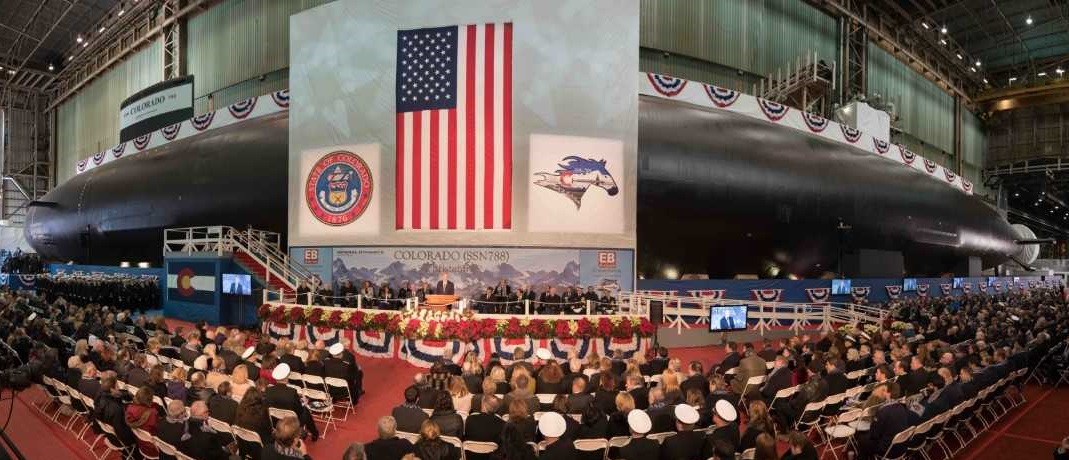KUSA - The newest Virginia-class nuclear submarine was commissioned March 17 at a naval base in Connecticut, the Navy announced this week.
Several big Colorado names attended and spoke, including Gov. John Hickenlooper and Sen. Cory Gardner at Naval Base New London.
The USS Colorado - named for the Centennial state - is the 15th Virginia-class sub to be commissioned since the program began in 2004, according to the Navy Office of Community Outreach.
It's 377 feet long and weighs 7,800 tons. The sub is about 34 feet tall and can go more than 25 knots while submerged, the Navy says. It's designed with a nuclear reactor plant and will not require refueling during the life of the ship.
It cost about $2.6 billion, according to the sub's commissioning committee.
"As the most modern and sophisticated attack submarine in the world, the submarine can operate in both littoral (shallow) and deep ocean environments and presents combatant commanders with a broad and unique range of operational capabilities," the Navy says in a news release.
It's got seven jobs - the core competencies of the submarine force: anti-submarine warfare, anti-surface warfare, delivery of Special Operations Forces, strike warfare, irregular warfare, intelligence, surveillance and reconnaissance, and mine warfare.
The Navy redesigned 20 percent of the Colorado as part of the Virginia-class' third contract - lowering its cost while keeping up its fighting capabilities. The ship lost its 12 individual Vertical Launch System tubes in favor of two large-diameter Virginia Payload Tubes each able to fire off six Tomahawk cruise missiles.
To accommodate special forces, its torpedo room can be refitted to support a large number of soldiers and their equipment during long deployments.
This submarine - like all in the Virginia class - doesn't have a periscope, according to the Navy. Instead, it's got two photonic masts that "host visible and infrared digital cameras atop telescoping arms, which are maneuvered by a video game controller."
The successor of the Los Angeles-class submarine of The Hunt for Red October fame, the Virginia-class subs could remain in service until 2043, according to a write up about the subs in Forbes.
This submarine is the fourth seagoing vessel commissioned by the U.S. Navy. The first was a screw frigate called the USS Colorado. Part of the Union fleet prior to the Civil War, it had 48 guns and was stationed in Boston, according to the Navy and Marine Living History Association. It was named after the Colorado River.
The second was an armored cruiser commissioned in 1905. It was 504 feet long and had a top speed of 22 knots. It was a Pennsylvania-class cruiser. According to Naval History and Heritage Command, the cruiser was built in Philadelphia and part of the Atlantic Fleet at Provincetown, Mass. before heading around to the Pacific to join the fleet there - even going out to the Far East.
In 1915, it sailed as the flagship of the Pacific Reserve Fleet and patrolled Mexican waters during the Mexican revolution. It was renamed Pueblo a year later to allow the Colorado designation to go to a newly built battleship.
The third ship to bear the Colorado name was Battleship No. 45 commissioned Aug. 30, 1923, in Camden, N.J. From 1924 - 1941, the Colorado was a part of the Battle Fleet in the Pacific, according to the Naval History and Heritage Command. Based in Pearl Harbor from January '41 to June, the ship left for the West Coast until its return to Hawaii in March 1942.
In October of that year, the ship left Hawaii to support the invasion of Tarawa in the Pacific theater before turning to port in December 1943, according to Naval history records. After refitting on the West Coast, it went to support the Marshall Islands operation by providing preinvasion bombardment and fire support during the invasions of Kwajalein and Eniwetok until it needed another overhaul.
The ship took 22 shells while bombarding Tinian in late July but continued to support the troops there for another 10 days. After repairs, it returned to the Leyte Gulf in November 1944 to support American troops fighting ashore. Just a week after its return, the ship was hit with two kamikazes, while killed 19 men and wounded 72 causing moderate damage to the battleship.
According to historical records, the Colorado continued on - shelling Mindoro in December and then rushing to the Manus Islands for emergency repairs. In January 1945, the ship bombarded the Lingayen before accidental gunfire struck her superstructure, killing 18 and wounding 51.
The battleship would continue to assist with various bombardments until it sailed to Okinawa on Aug. 6, 1945. It left Tokyo in September and returned to the U.S., participating in the Navy Day celebration on October 27 in Seattle.
The ship brought 6,357 veterans home during its "Magic Carpet" duty afterward. The ship was decommissioned in 1947 and sold for scrap in 1959. It received seven battle stars for World War II service.
Now, the Virginia-class submarine bears the Colorado name, the third Navy vessel to be named for the 38th state in the Union.

